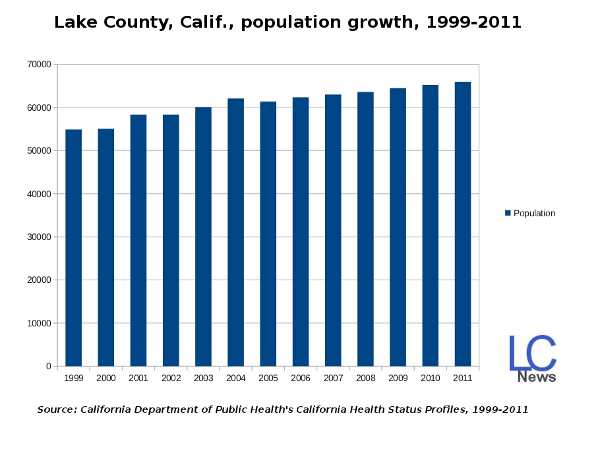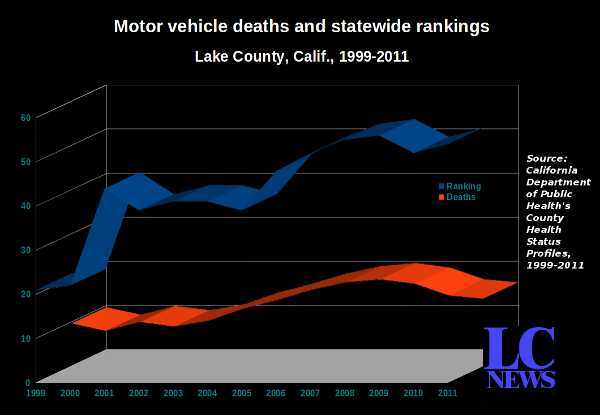Hazards Ahead: Vehicle crash rates among Lake County's chief health issues
This is the first installment of a special series on highway safety and its impact on Lake County residents' health.
Part 1: Vehicle crash rates among Lake County's chief health issues
Part 2: Alcohol adds a deadly element to area roadways
Part 3: Many agencies contribute to roadway safety projects, planning

Winding roadways, infrastructure, speed and weather conditions are among the factors that affect travel along county roadways. This vehicle went into the Rodman Slough in Lake County, Calif., on Tuesday, March 2, 2011. The crash, which resulted in no injuries for the car's occupants, was one of many during the year so far involving vehicles going into Clear Lake.
LAKE COUNTY, Calif. – Sweeping vistas, clear blue skies, colorful countryside – all define Lake County's geography.
Traversing the landscape are numerous roadways, winding between lakes and mountains, dotted by wildlife and, at times, busier thanks to the tourist season.
Highways 20, 29 and 53 link Interstate 5 with Interstate 101, establishing Lake County as a primary traffic thoroughfare for travelers.
For motorists, the roads are both beautiful and harrowing, with the number of vehicle crashes in recent years showing a marked increase.
The 2010 Lake County Health Needs Assessment identified vehicle crashes as a significant health concern for county residents, pointing to evidence that the rate of fatal vehicle collisions in Lake County was well above state and national averages.
Lake County Health Officer Dr. Karen Tait said many of Lake County's health challenges, even simple tasks like driving to the store, result from the nature of rural living.
“Rural areas just have more accidents of all types,” said Tait.
In addition, Lake County's road infrastructure has been identified as needing significant improvement, and numerous health studies have pointed to higher-than-average rates of drug and alcohol abuse.
Then, there is the changing nature of society, where greater access to technology can sometimes translate into increased distractions when behind the wheel.
Lt. Mark Loveless, former commander of the California Highway Patrol’s Clear Lake area office – who earlier this year took a new assignment in Trinity County – said he's seen more collisions resulting from drivers using their cell phones to send texts and place calls, despite the fact the practice is illegal.
“That's not specific to Lake County,” he said, adding that people forget how important it is to stay focused when driving.
Early this year, Lake County News was selected for a California Endowment Health Journalism Fellowships from the University of Southern California Annenberg School for Communication & Journalism.
The purpose of the fellowship is to study a significant health issue affecting our readership.
The result is a series of articles focusing on Lake County's high number of vehicle crashes, listed among nine causes of death for Lake County residents that surpass state and national rates, according to figures included in the 2010 Lake County Health Needs Assessment.
In addition to this assessment, other sources for this special series include the Lake County Health Department, California Highway Patrol, the California Department of Transportation, Statewide Integrated Traffic Records System, Clearlake Police Department, Lakeport Police Department, Lake County/City Area Planning Council, the California Department of Public Health, the University of Wisconsin Population Health Institute's county health rankings and the 2010 U.S. Census.
As part of the project, Lake County News has created a first-of-its-kind map for the community – to be introduced later in the series – which documents crash statistics from Jan. 1, 2006 to today.
The map, created with the assistance of the California Highway Patrol, Lakeport Police and Clearlake Police, will become a permanent, regularly updated feature of Lake County News' Web site.
In addition to the map, the assessment of county roads that will be presented in the series will include an evaluation of contributing factors and what steps officials are taking to address the problems, including grant projects.
Another part of the series will consider whether measures taken to improve safety actually succeed, and how state and local officials determine where safety projects should be completed.

By the numbers
The 2010 Lake County Health Needs Assessment reported that over a three-year period – 2006 to 2008 – Lake County’s motor vehicle crash age-adjusted death rate was 22. That’s compared to the state rate of 10 and the national rate of 14, and well above the national health objective of eight, established by the U.S. Department of Health and Human Services’ Healthy People 2010, which sets goals and objectives for health.
Historically, Lake County's highways have been challenging. Residents’ accounts of county roads and highways describe narrow and treacherous byways which predate the arrival of the automobile at the turn of the 20th century.
Today's highways are safer, but still pose their challenges, as they move through narrow mountain passes and along the lake's curving shores.
The county's tourism trade and a growth in population over the past decade – 20 percent, based on state population estimates – appear to be contributing factors to rising crash rates.
Most factors affecting Lake County's high crash rate are fairly basic in nature, Tait said.
For one, road quality is a part of the equation, according to the Lake County 2030 Blueprint, a planning document completed in October 2010 by the Lake County/City Area Planning Council.
The document, funded through Caltrans grants, provides county governments a coordinated regional framework to help guide planning decisions.
The blueprint quotes a projection from the California Department of Finance Research Unit that Lake County’s population is projected to grow to around 101,000 residents by 2030, roughly a 55-percent increase. The latest U.S. Census numbers put the population just under 65,000.
“Poor road conditions and lack of safe bicycle and pedestrian access,” are the county's No. 1 challenge, according to the document. Lack of access to shopping and services, lack of medical resources and transportation to health care, and drug use also were cited.
Average pavement conditions ranked as poor
June 2008 pavement studies for Lake County, Lakeport and Clearlake, completed by the Lake County City Area Planning Council, didn't offer a promising picture for county roadways.
The study’s pavement condition index includes five rankings: very poor, 0-25; poor, 26-50; fair, 51-70; good, 71-90; and excellent, 91-100.
The unincorporated county's overall ranking was 32, or “poor,” with only 12.1 percent of county pavement in the “good” or “excellent” condition category.
“There is very little good news to present in this report,” the report on county roads stated, adding that the county’s existing budget of $300,000 per year for road maintenance isn’t enough to maintain roads, and that the pavement condition index is likely to decrease to 12, in the “very poor/failed” category, over the next decade.
The report recommended the county increase its current funding level for road maintenance to at least $8.9 million per year – an unlikely outcome for the small rural county – and increase inspections for streets. Estimated total road replacement costs for the entire county are $468.3 million.
A similar report completed for Lakeport found the city had estimated road replacement costs of $58 million, an average pavement condition index score of 35, still in the “poor” category, and had 12.2 percent of its pavement in the “good” or “excellent” category. If the city isn’t able to increase its road maintenance budget, but 2017 the average road condition rating is anticipated to drop to 13, or the lowest level, “very poor/failed.”
Clearlake's pavement picture was slightly better. It also ranked in the poor category, with a pavement condition index of 39. Overall, 17.5 percent of the city's roads rated as good or excellent. Because of budget constraints, road conditions are expected to decline to a 19 rating in the next decade. Total road replacement for the city would cost $53.3 million.
City and county officials said pavement condition index updates now under way and expected to be released by early 2012 show improvements in those numbers thanks to the completion of a number of projects over the last few years.

Additional studies identify vehicle crash rate as health issue
The University of Wisconsin Population Health Institute's county health rankings, released this spring, concluded that Lake County's motor vehicle crash fatality rate placed it in the 90th percentile for California counties – among the worst in the state – for years 2001 to 2007.
Lake County received a crude death rate score of 28 deaths per 100,000 population, the same rate as Amador and Tuolumne counties.
Other rural areas like Glenn, Del Norte and Trinity – the latter two having mountainous and winding roads often traversed by tourists – had worse rankings than Lake, at 29, 31 and 47 per 100,000 population, respectively.
In assessing the impacts of motor vehicle crashes on public health, Lake County's geography and infrastructure can't be ignored, said Tait.
Along with having to travel longer for some services – and stay on the road longer for minor errands – Tait said some of Lake County's roadways are narrower, have less lightning and have wildlife crossing them as well.
“I'm really pretty convinced that that basic infrastructure is what really makes a difference,” she said.
Tait said on a recent drive to a local friend's house she realized that the roadway where she was driving wasn't really wide enough for two lanes.
“Some of our roads just aren't really what people expect,” she said, especially for visitors and tourists who may find themselves off the beaten path.
With Lake County's dark roadways, abrupt road edges and lack of engineering in some places, it can be a unique challenge, said Tait.
“People who live here, the prudent ones, learn to be cautious,” she said, adding that not everyone is.
But perhaps more significant still is the impact of alcohol use by drivers who take to the county's roads.
The 2010 Lake County Health Needs Assessment found Lake County’s average rate of alcohol-involved motor vehicle fatalities for 2001 to 2003 was three times higher than the state average.
In the next installment, assessing the impact of alcohol use on highway safety.
